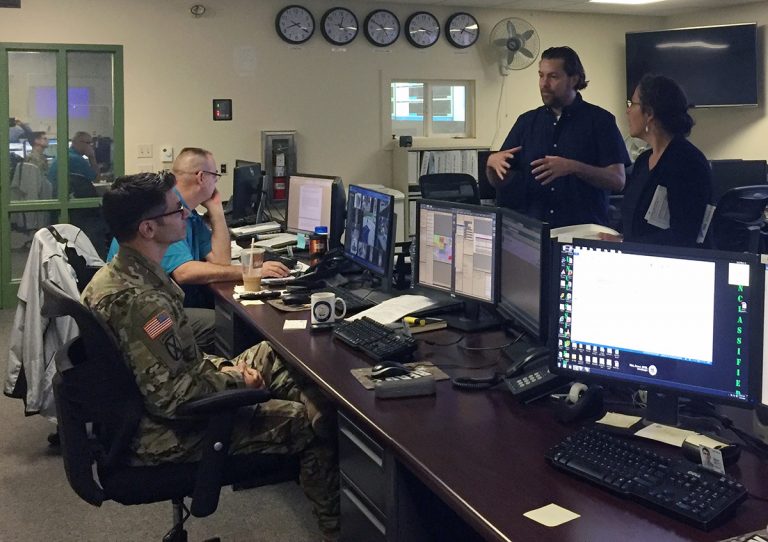This year’s hurricane season has been one of the most active on record, with devastating impacts on coastal communities, including eastern Texas, both coasts of Florida and all of Puerto Rico. While hurricanes Harvey, Irma and Maria slammed the Gulf and the Caribbean, communities further north are preparing for their own high-impact storm: a hypothetical “Hurricane Rhody.”

Researchers at the University of Rhode Island (URI) are working to improve the safety and preparedness of Northeastern coastal communities by using model hurricane simulations. These simulations have served as a tool for emergency managers during state-level emergency planning exercises.
Dr. Isaac Ginis has developed a computer model for assessing the impact of potential hurricanes in the Northeast as part of a project with the Coastal Resilience Center of Excellence (CRC). “Modeling the combined coastal and inland hazards from high-impact hypothetical hurricanes” includes the development of an advanced, multi-modal ensemble system used for realistic computer simulations of hurricane hazards and impacts.
Dr. Ginis serves as the project’s principal investigator, and collaborates on the model with URI Drs. Chris Kincaid, Tetsu Hara, Lewis Rothstein and David Ullman. Other research partners include Florida State University professor Dr. Wenrui Huang; the National Oceanic and Atmospheric Administration’s Environmental Modeling Center, Northeast River Forecast Center and the National Weather Service Forecast Office in Boston.
“The primary goal of our project is to assess the impact of very large, extreme hurricane events using the most advanced numerical models,” Dr. Ginis said. “We’re going to use multiple scenarios based on real storms in the past, but also hypothetical scenarios that have never happened but could happen.”
The model Dr. Ginis and his collaborators combine data from hurricanes that have had severe impacts on Rhode Island in the past with hypothetical worst-case scenarios to simulate the outcomes of potential storms. Hurricane Rhody is a hypothetical storm that would directly affect Rhode Island with hazards such as winds of more than 130 miles per hour and significant coastal and inland flooding.
“One of the key elements of our approach is to combine the impact of coastal flooding due to storm surge and inland flooding due to rainfall simultaneously, which hasn’t been done before,” Dr.Ginis said.
The physical models apply 3-D visualizations to display the impact of these hazards on critical infrastructure, evacuations and critical operating systems like transportation and utilities. With a recent grant from the Microsoft Azure Research Award, Ginis and his team will be able to utilize cloud computing to improve their models and develop more visualization products for emergency managers.

“This project will allow federal, state and local agencies to better understand the consequences of coastal and inland hazards associated with extreme high-impact hurricanes and to better prepare coastal communities for future risks,” Dr. Ginis said.
Model predictions have already helped emergency managers, first responders and other decision-makers in planning for Hurricane Rhody, while also providing new insights into the effects sea-level rise will have on future scenarios.
Last June, emergency managers partnered with the URI researchers in a four-day statewide preparedness exercise using the Hurricane Rhody simulations. The Rhode Island Emergency Management Agency (RIEMA) and Federal Emergency Management Agency (FEMA) led the trainings, which were attended by more than 100 emergency managers from Rhode Island municipalities, state agencies, non-profit organizations and FEMA Region 1 and focused on response to hurricane scenarios.
RIEMA is considering use of the presented materials for further trainings and exercises to update state materials to current threat standards.
“The information and modeling provided by URI will be used within RIEMA-sponsored trainings and exercises to update the scientific data and modeling used,” Stephen Conard, RIEMA Training & Exercise Specialist, said.
Dr. Ginis said further outreach is planned.
“We plan to convene a statewide ‘Hurricane Rhody Workshop’ to bring together planners and decision-makers from all levels so they could grapple collectively with the response for a catastrophic event and start the process of reviewing and reconciling their existing emergency plans,” he said.
The project has also helped improving hurricane forecasts through collaboration with NOAA scientists. In 2016, Ginis’ team made contributions to the National Weather Service’s hurricane prediction models and other models to help track storms in the Northern Hemisphere. Ginis has received a Certificate of Appreciation from NOAA for his contributions.
This project will allow federal, state and local agencies to better understand the consequences of coastal and inland hazards associated with extreme high-impact hurricanes and to better prepare coastal communities for future risks.
Dr. Ginis says the next step in his research is to improve predictions on the strength and impact of hurricanes. The 2017 hurricane season has highlighted the remaining challenges in forecasting extreme hurricane intensity and rainfall, he said, and collected data will be used to further advance operational hurricane prediction models.
“This is still one of the most challenging problems we are facing in terms of hurricane prediction,” he said. “We’ve made huge progress in forecasting the hurricane track, but still there are significant challenges to predict how strong a hurricane is going to be.”
Ginis says there are many factors that can influence a hurricane’s intensity, which is part of the reason those predictions are so hard to make.
“That is still a very difficult question to answer,” he said. “We are making progress.”
